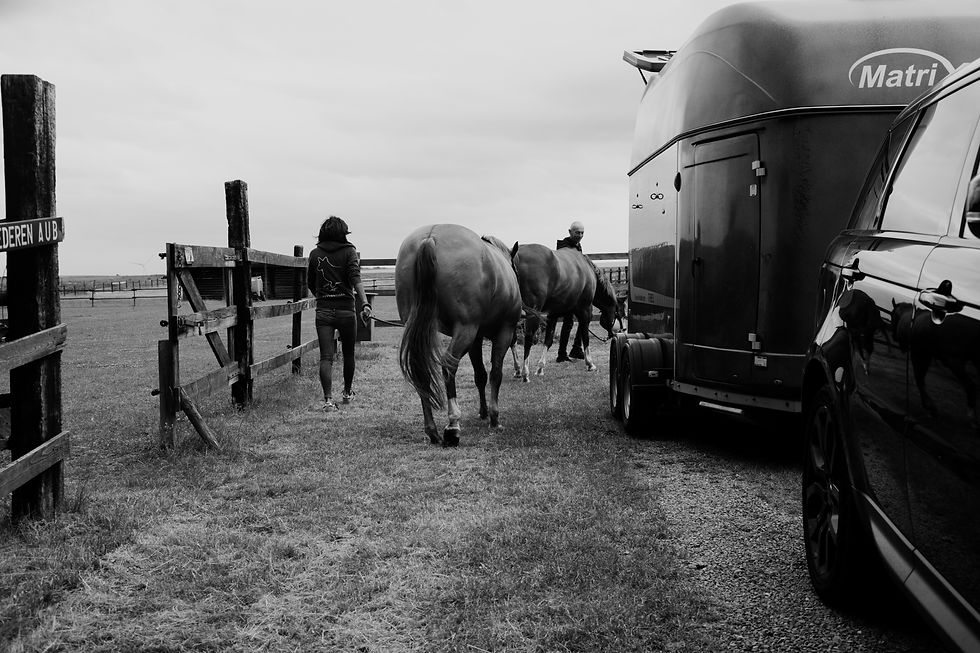Scrambling occurs when a horse on a float or trailer loses its footing and attempts to regain balance. It is one of the main courses of injury while travelling.
One study (Horse Injury During Non-Commercial Transport) found that floating injuries occurred predominantly due to horse behaviour, rather than the driver.
They found that 72% of the injuries were described as horse associated – that is, from scrambling, slipping or horse-to-horse interaction. The researchers found that another 11% were due to mechanical failure, and 6% due to driver error.
The study team reported that 193 of the participants moved their horses by trailer, for a reported injury rate of 22.8%. The remaining 30 moved their horses by small truck, with a reported injury rate of 36.7%.
Trailer-associated injuries usually occurred during vehicle movement (86.4%), and less frequently during unloading (6.8%), loading (2.3%) and while stationary (4.5%).
Similarly, truck-associated injuries usually occurred during vehicle movement (72.7%), and less frequently during unloading (9.1%), and loading (9.1%). No injuries were reported in trucks while stationary.
Later in the article the authors suggest that drivers having inadequate sleep, texting, and also swerving or braking to avoid another vehicle were contributing causes of injuries, but accounted for less than 10% of injuries.
It can be very distressing when your horse scrambles on the float, and particularly frustrating if they have previously travelled well. There are endless threads on this topic on online horse forums and very little of it is helpful, because most suggestions are to buy a different type of float, buy a truck, or buy a different horse.
So what can you do with your own horse and float?
In their article 'Reforming a Horse Trailer Scrambler", Equisearch suggests that horses have trouble getting their bearings in the small space, and removing the centre divider can help.
In trying to get back on his feet, a horse like this can lose track of which surface is the floor and which is the wall. He may, in effect, be trying to regain his footing on the wall instead of the floor. This problem is easier to fix than claustrophobia.
With many scramblers, the center divider can be the culprit. Center dividers that go all the way to the floor can keep larger horses from spreading their legs wide enough to keep their balance. Once the horse loses his balance, a chain reaction sets in. He scrambles up the wall trying to find his footing, which only further upsets his balance. Replacing a full center divider with one that comes halfway down often helps.
In the course of the article they gave the example of removing the centre divider altogether and gradually replacing it with a piece of rope while the horse gets used to the parameters of the space. They encourage moving a stallion divider if one is in place, and also leaving enough lead rope for the horse to drop their head, or turn their head to see behind them should they choose to.
Another point made was that the padding in a float has too much give and the horses feel unable to trust it with their weight. Removing some of the padding, particularly on the side walls, so that the horse can lean against something solid may help them feel more stable.
In A Survey on Transport Management Practices Associated with Injuries and Health Problems in Horses by Barbara Padalino et al, the authors suggested that horses are least stable facing the direction of travel in a straight-load two-horse float, and more stable on an angle-load, or facing away from the direction of travel.
If you are travelling with one horse, you may be able to move the centre divider to the side in a straight load so that the horse can choose to travel diagonally.
The Horse Side Vet Guide suggests that you can take your horse on very short trips (preferably on your own property rather than with the unpredictability of traffic) completely loose on the float, so that they can establish their own bearings, and you can see their preference. Then gradually increase the length of the trip, and start to introduce limits like tying and dividers.
Finally, maybe ride by yourself in the float (on your own property) to see if there is a noise, or a draught, or something that you notice on the float in motion that may be distressing your horse.

Sources:
Non-commercial Horse Transport: New Standards for Trailers in Canada
Sharon E. Cregier, Rebecca Gimenez, Editors November 2015
Australian study highlights non-commercial horse transport risks, Horsetalk October 27, 2016
Horse Injury During Non-Commercial Transport
Christopher Riley, Belinda Noble, Janis Bridges, Susan Hazel and Kirrilly Thompson "Animals" 2016 6/11
Barbara Padalino, Sharanne L. Raidal, Evelyn Hall, Peter Knight, Pietro Celi, Leo Jeffcott, Gary Muscatello
PLOS | One Published: September 2, 2016
Equisearch - Reforming a Horse Trailer Scrambler MAR 20, 2017
https://horsesidevetguide.com/

Comments